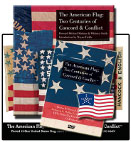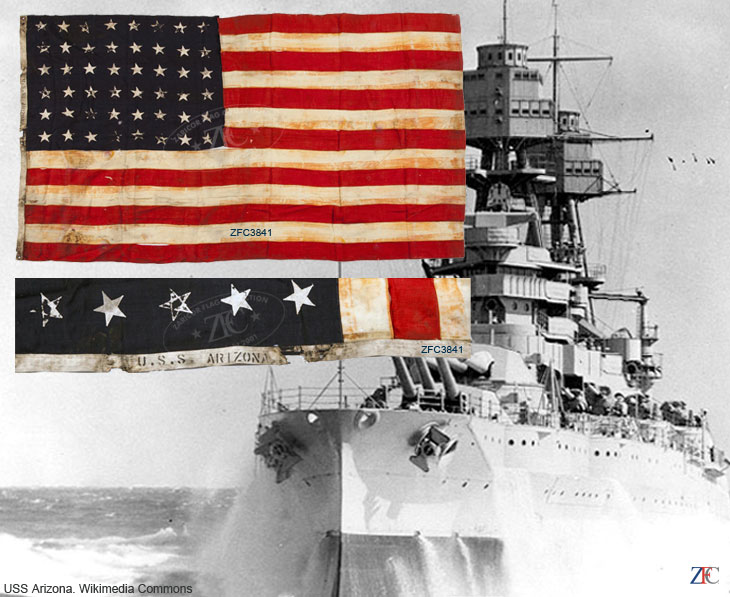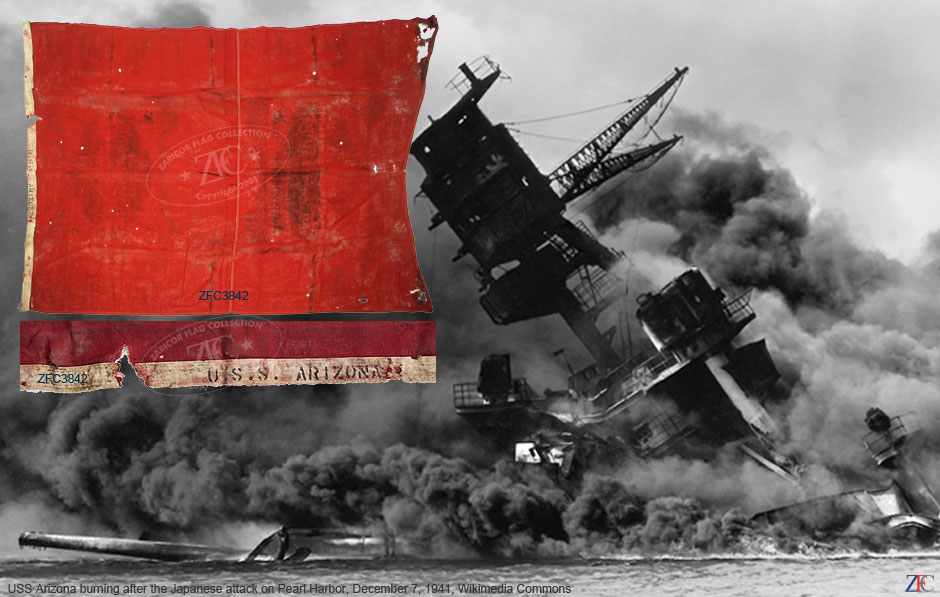The Zaricor Flag collection: Two Centuries of Concord & Conflict
The Zaricor Flag Collection (ZFC), as the noted flag historian, the late Howard Madaus stated, Is the largest most important representation of U.S. and American flags in the world. Containing many important foreign flags, the ZFC is more than a large accumulation; rather it is a dynamic working collection, used for research, exhibition and educational purposes. Read more >>
"A DATE WHICH WILL LIVE IN INFAMY"
The United States became belligerent in WWII after the Japanese attack on Pearl Harbor, Hawaii on the "Day of Infamy", December 7, 1941, when a surprise military strike conducted by the Imperial Japanese Navy against the United States naval base destroyed the battleships of the U.S. Pacific Fleet. The destruction of the battleship USS Arizona (BB-39) by an aerial bomb has become the singular symbol of America's entry into Second World War.
U.S. flags recovered from that ship are extremely rare, and represent the "alpha" of WWII U.S. collectibles. (NB: Please see Grouping #39 for the "omega" of U.S. collectibles, artifact relating to Hiroshima.) The WWII U.S. Naval Grouping commences with such, a 48 star flag marked U.S.S. Arizona that was later used to accompany the effects of Rear-Admiral Isaac Kidd on its return to Annapolis for his memorial service at his cenotaph. According to the US Naval Academy the ship is one of if not the most important naval battle vessels in the history of the US Navy. To have a flag from that vessel is of great importance to history and this collection is honored to be the repository of such a relic of historical importance.
Recovered from the USS Arizona along with the U.S. 48 Star Flag is a signal code flag, labeled with the pre-war identification "USS ARIZONA". After study by the Zaricor Flag Collection (ZFC) Research Group two possibile explanations resulted for this Code Baker signal flag and its companion US Ensign (ZFC3841) which were either in or on the USS Arizona during the surprise Japanese attack 7th of December, 1941 at Pearl Harbor Oahu, Hawaii, U,S, Territory Naval and Army Air Corp bases.
USS Arizona December 7th, 1941 Youtube, CAI9347
Also, included in the Naval Grouping are two flags from the USS Enterprise (CV-6) the most famous ship in the United States Navy during WWII. The USS Enterprise fought in every major sea and air battles in the Pacific Theater except one and that was due to it put up for repairs towards the end of the war. The USS Enterprise had 20 Battle Stars during the war more than any ship in any navies during the war, allied and enemy alike, including all theatres of war. It is the only original carrier from the beginning of the war including the Japanese fleet battleships and carriers to survive the war.
Also included in this section is a rare flag from a US submarine, an ensign from the USS Jallao (SS3-68) along with it's insignia plate from the boat (submarines are called boats not ships). It was part of a strategic combination of aircraft carriers and submarines that led to victory in the Pacific.
Also presented in this grouping are flags and artifacts relating to the U.S.M.C, the U.S. Navy's Construction Battalions or Sea-Bees as well as other flags and ephemera that articulate the story of the U.S. Navy in WWII in the Pacific Theatre.
Most notably included is the famed Associated Press photographer Joe Rosenthal's personal photo album of Iwo Jima photographs, including his iconic Pulitzer Prize winning photograph of the flag raising on Mount Suribachi during the Battle of Iwo Jima. There are 52 photos that show in graphic detail the harsh conditions and savage fighting during the 35 days it took the US Marines, Navy and Army to neutralize the enemy on its home territory in Feb. 1945.
An interesting footnote to the intensity of the fighting is that while the photo album was couriered to its new home in California from New York the TSA alarm system was triggered at the airport while the photo album went through screening. It was determined the photo album was embedded with cordite dust and particles left over from the battle on Iwo Jima 63 years before. This gives one an impression how intensely the battlefield was covered with TNT/black powder during the battle.

ZFC3841 - U.S. 48 star flag from the USS Arizona, December 7th 1941
This flag marked with pre-WWII identification "USS ARIZONA" was recovered from the hulk of the USS Arizona. It is only one of three known U.S. ensigns recovered from the USS Arizona, after she received her final blow during the surprise Japanese attack on December 7, 1941.

ZFC3842 - U.S. Navy Signal Flag 'Baker' marked USS ARIZONA
This red cotton swallow tailed signal flag was recovered from the USS Arizona after the 7 December 1941 attack on Pearl Harbor, Hawaii by the Imperial Japanese Navy Air Wing that resulted in the destruction of the ship.

ZFC3866 - USS Arizona passing Diamond Head - 11/28/41
This limited edition print depicts two of the ships associated with significant World War II flags in the Zaricor Flag Collection: a 48 star ensign form the USS Arizona (ZFC3841) and a 48 star jack from the USS Phelps (ZFC1083).

ZFC3843 - U.S. 48 star #10 Ensign of the USS Enterprise
This ensign was worn by the USS Enterprise (CV-6) in 1945, and was retained by a crewman from that aircraft carrier, the most storied and decorated U.S. combat vessel of WWII. The name Enterprise has been borne by nine different ships since the beginning of the Republic.

ZFC3844 - Admiral Absent Signal - USS Enterprise (CV-6)
The tag attached to this signal flag identifies it as an "Admiral's Absence Pennant." It is recorded as having flown from the yardarm of USS Enterprise (CV-6) during the absence, from that aircraft carrier, of an admiral. Sadly the name and grade of that flag officer was not recorded.

ZFC3280 - U.S. Navy Rear Admiral John Ballentine Flag
This small, blue woolen Auto & Miniature flag with two white five-pointed stars arranged vertically and finished with a sleeve and ties was used by John Jennings Ballentine, during WWII, who was a Rear Admiral in the United States Navy.

ZFC3851 - U.S. Marine Corps Eagle Globe & Anchor Plaque - Theater Made - Guadalcanal
This U.S. Marine Corps Eagle Globe and Anchor insignia (EGA) was carved from a single piece of wood on Guadalcanal sometime in 1942/43. It depicts a full color EGA on a stylized daylight sky, surrounded by a rope border over the designation "GUADALCANAL."

ZFC3850 - Co. "C" 4th Marines - Animal Aggression - Unofficial Guidon, WWII
This unofficial, USMC guidon was likely used as a "hooch" or company room decoration to boost morale. This guidon's history has not yet been accurately determined as the unit designations have engendered three possible explanations

ZFC1083 - U.S. 48 stars Union Jack - U.S.S. Phelps
1st U.S. Flag hoisted over Japanese Home Territory WWII, Feb. 1944. Upon dropping anchor in the harbor of Kwajalein, this "jack" (symbolizing the reuniting of the ship with "mother earth") was raised at the ship's bow, in accordance with navy traditions.

ZFC3854 - 48 Star US Ensign of submarine USS Jallao, 1944
This 48 Star U.S. Ensign was used by the USS Jallao (SS-368) in the Pacific in 1944 and 1945. The flag is a commercially made cotton flag with wartime grommets. It was likely acquired by private purchase by the Jallao for use when entering or leaving port.

ZFC3855 - USS Jallao (SS-368) Battle Insignia
The Jallao's battle insignia was a stylized greenish Jallao fish, wearing the distinctive white "Dixie Cup" sailor cap of the U.S. Navy and striking a fierce pose at it aggressively gestures with a torpedo - the distinctive arsenal of submarines.

ZFC3857 - U.S. Navy Rear Admiral Flag - Chester Carl Smith - Submarine Ace
This large size # 6, blue woolen flag with two white vertically-centered five-pointed stars, was used by Carl Chester Smith at the close of WWII. Smith was an able U.S. Naval officer who rose in grade from Lt. Commander to Rear Admiral between 1941 to 1945.

ZFC3858 - Rear Admiral C.C. Smith's USN Combination Cover
This is a U. S. Navy Combination Cover. It is referred to as a combination cover because this form of hat may be used with a variety of "covers" in different colors and materials in combination with the uniform of the day; as prescribed by the station, base or vessel's commanding officer.

ZFC3881 - US Newspaper "The Evening Bulletin" Feb 19, 1945
This Feb 19, 1945 issue of the "The Evening Bulletin", Philadelphia's dominant newspaper portrays how Marines fight way into Air Strip on Iwo Jima

ZFC3849 - Joe Rosenthal's Personal Iwo Jima Photo Album
This album contains 52 photographs shot by Joe Rosenthal Associated Press (AP) over three weeks during the heart of the Battle of Iwo Jima February, 1945.

ZFC3194 - U.S. - Joe Rosenthal Photograph, 38th Anniversary of Iwo Jima
Iwo Jima Flag Raising photo, autographed by Joe Rosenthal, the Iwo Jima flag raising photographer, and inscribed "Best wishes to Harry Brand from Joe Rosenthal."

ZFC3877 - US Photo of Felix De Weldon, John Bradley & Wife
This is a picture of Felix De Weldon with Iwo Jima Flag Raiser John Bradley and his wife.

ZFC3867 - Rare Historical Sound Recording of U.S. Marine Corps Band at the Iwo Jima Monument Unveiling Ceremony November 10,1945
For the 170th Birthday of the Marine Corps in 1945, the Original Iwo Jima Monument was revealed in a Ceremony in Washington. A local radio station recorded the ceremony.

ZFC3873 - U.S. Rare model of Iwo Jima Statue - Quantico
This is a rare model of the Iwo Jima Statue at the entrance of Quantico (note the rectangular shape of the base).

ZFC3876 - U.S. Flag Raiser John Bradley's Belt Buckle, WWII
IWO JIMA - Flag Raiser John Bradley's Belt Buckle. Engraved "U S N" in addition to the Marine Corps Eagle-Globe-Anchor insignia, as Bradley was a Navy Medical Corpsman assigned to the Marines. On Exhibit at The Intrepid Sea Air Space Museum, 1995 - 2007.

ZFC2404 - Japanese Sailor (Hinomaru Yosegaki) "Good Luck Flag", Manila, 1945
This Good Luck Flag was inscribed to an Osaka sailor form his family and friends, including the mayor of Osaka. It was recovered from a ruined factory in Manila along with the sailor's identity tag (see ZFC2405).

ZFC2405 - Japanese Imperial Navy Wooden Sailor's ID tag
This dog tag belonged to a Japanese sailor who died in the Japanese defense of Manila in 1945. Metal was so scarce in wartime Japan that by 1945 conscripts were being issued ID tags made of wood. This was recovered from the body of a Japanese sailor and was found with a flag (see ZFC2404)

ZFC1305 - Imperial Japanese War Flag - 1870 to 1945
Imperial Japanese War Flag - 1870 to 1945. Small silk flags like this were sometimes used as Hinomaru Yosegaki or a "Good Luck Flag". Often purchased by relatives and friends, they were generally kept on a soldier's person.

ZFC2549 - Imperial Japan National Flag, 1942-1945, taken by 2nd US Marine Air Wing
This Japanese flag was acquired by members of the USMC 2nd Air Wing who defaced it with their battle honors, their distinctive unit insignia, a drawing of a Japanese fighter plane giving off smoke, and a caricature of a another about to be bombed.

ZFC3265 - Imperial Japan, Trophy Flag of the 18th U.S. Navy Construction Battalion, WWII
Surviving Japanese flags from WWII are plentiful since almost every Japanese soldier or sailor flew one. What makes this particular flag significant is the "sailor art" painted over the field of the flag detailing the wartime services of Louis Mauriello.

ZFC3853 - Enola Gay Hiroshima Log - Capt. Lewis USAAF, Co-Pilot
Mimeographed original copy and only transcript of Lewis' original log written in flight on the morning of 6th August, 1945, formerly in the possession of the Atomic Bomb Supervisor Captain William "Deak" Parsons. [August, 1945] where Lewis famously quotes, "My God what have we done?"

ZFC3860 - Col. Paul W. Tibbits, Enola Gay Hiroshima pilot - personalized autograph card
This small card was autographed and dedicated to Bruce David Weiss by Colonel Paul W. Tibbits. He was the pilot of the B-29 Enola Gay which, on the 6 August 1945, completed its mission to drop the first atomic bomb on Japan and hasten the end of WWII.

ZFC3864 - Fat-Man Atomic Bomb - Theater-made Model, 1945
This diminutive wooden, theater-made model is deceptive. At only a few inches in length, drab to the eye and very lightweight, it betrays nothing to indicate that the full-sized device was one of the most destructive weapons of WWII: the 2nd atomic bomb used in combat, "Fat Man".

ZFC3288 - U.S. Navy Fleet Admiral's Personal Flag from WWII
This well worn, dark blue wool rank flag defaced with five white stars is unmarked and does not reveal which of the four men entitled to it, as Fleet Admirals, might have displayed it during WWII.

ZFC3275 - U.S. Army General of the Army Personal Flag, 5 Stars, 1944-1945, WWII
This extremely rare, wool, five-star rank flag designates the personal presence of General of the Army, the highest possible wartime grade in the United States Army.




